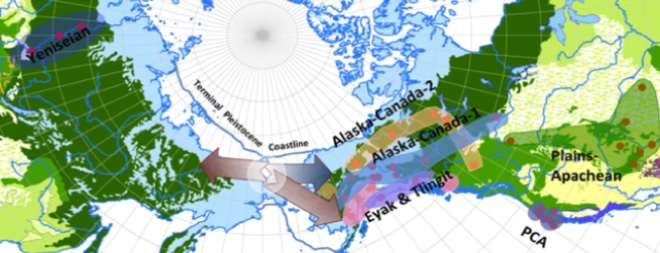
(ISNS) -- The first settlers of the New World may have spent 10,000 years on Beringia, a vast land bridge that once connected Asia and Alaska, according to a new analysis of modern languages spoken by Native Americans and people in Siberia. The findings support similar conclusions of recent genetic and environmental studies.
Moreover, the findings, published online in the journal PLOS One, suggest that while many of these “Beringians” eventually pushed onward into North America, others returned, or “back-migrated,” to their homeland in Asia.
Mark Sicoli and Gary Holton from Georgetown University in Washington, D.C., and the University of Alaska Fairbanks, respectively, collected data on sound systems and word structure from published grammars of a group of languages spoken by Native Americans, called Na-Dene, and the Yeniseian languages of Central Siberia.
The pair then analyzed the linguistic dataset using a technique originally developed to investigate evolutionary relationships between biological species. Called computational phylogenetics, it involves constructing a tree to represent relationships of common ancestry based on shared traits. “Incorporating [methods from computational phylogenetics] into linguistics can increase the dialogue between linguistics, archaeology, biology, and ecology in developing our understanding of prehistory,” Sicoli wrote in an email to Inside Science.
The researchers used computational phylogenetics to model different ways in which the approximately 40 languages that make up the Na-Dene and Yeniseian language groups spread and evolved across North America and Asia. The model that scored the highest on a statistical test the researchers devised involved an early dispersal of Na-Dene along the North American coast with a Yeniseian back migration through Siberia, followed by a later dispersal of North American interior Na-Dene languages. The research also suggests Na-Dene and Yeniseian languages once shared a root language, called Dene-Yeniseian, that originated somewhere on Beringia.
These latest findings add to a growing number of genetic and environmental studies that point to an ancient extended human presence in Beringia. For example, genetic studies show that the DNA of Native Americans is distinct from that of their Asian ancestors. Using DNA mutation rates, scientists have calculated how long it would take for the genetic differences to accumulate and concluded that the people who migrated to the New World must have split from their Asian ancestors in Siberia about 25,000 years ago. But, the earliest undisputed evidence of people in the Americas dates back to only about 15,000 years ago, so some scientists speculate that humans must have settled somewhere for the 10,000-year interval.
The migrants, the reasoning goes, would have had to live somewhere sufficiently isolated for their genome to become distinct from that of their Asian ancestors. Rising sea levels have drowned much of Beringia, but during the last Ice Age, the land bridge measured as much as 1,000 miles from north to south, and as much as 3,000 miles from east to west, making it one possible location for a human settlement.
Get the world’s most fascinating discoveries delivered straight to your inbox.
Support for the so-called “Beringia standstill hypothesis” has also recently come from the field of paleoecology — the study of ancient environments. Scientists drilling sediment cores in the Bering Sea and bogs in Alaska have unearthed plant and insect fossils that indicate Beringia was dotted with sylvan oases of brushy shrubs and even trees such as spruce, birch, willow, and alder. These woody refuges would have provided fuel for fires, raw material for shelters, and cover for animals such as hares, birds, elk, and moose, which humans could have hunted for food.
“We now have three sources of information that support [the Beringia standstill hypothesis],” Sicoli said.
Dennis O’Rourke, an anthropological geneticist at the University of Utah in Salt Lake City, agreed that the linguistic and genetic evidence for an extended human presence in Beringia appear to be very complimentary. “It seems to be quite consistent with the genetic analysis that led to the Beringia standstill hypothesis,” said O’Rourke, who was not involved in the study.
O’Rourke noted that there is even genetic evidence supporting the idea of a back-migration from Beringia into Asia. “There’s at least one or two mitochondrial lineages” – DNA markers that are passed down only from mothers to their children – “in modern-day Asians that as best we can tell arose from the Beringian population,” he said.
Sicoli and Holton are applying computational phylogenetics to other languages around the world, such as the Alor-Pantar languages of Southern Indonesia and the Oto-Manguean language family of Meso-America.
Inside Science News Service is supported by the American Institute of Physics. Ker Than is a freelance writer based in Southern California. He tweets at @kerthan.
